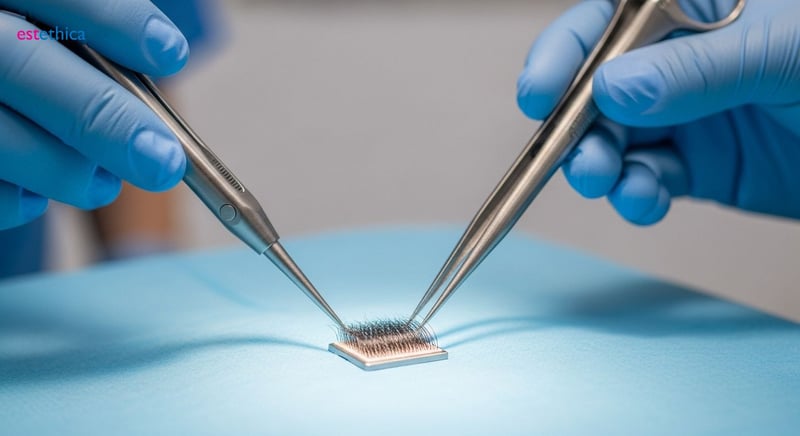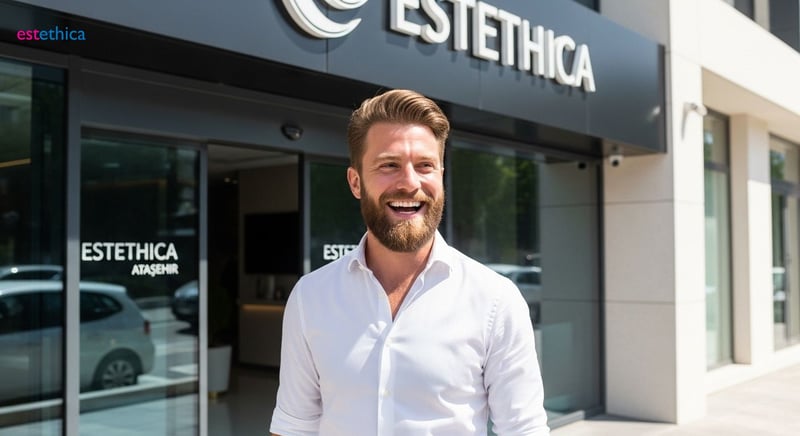Crafting Confidence: Your Guide to the Ideal Beard Transplant
Master your beard transformation journey with knowledge on transplantation techniques and recovery insights.
Discover the ultimate guide to beard transplantation, providing a comprehensive overview of the latest techniques and recovery insights, alongside expert advice on achieving natural and gratifying results.
Decoding Facial Hair Restoration: Is a Beard Transplant Right for You?
Ideal Candidates for Facial Hair Restoration
Facial hair restoration, particularly through a beard transplant, appeals to individuals with sparse or uneven beard growth. Candidates often include those whose beard development has been affected by genetic predispositions, trauma, or previous surgeries. For instance, men with naturally thin facial hair, burn scars hindering growth, or those seeking to refine their beard's density and shape constitute ideal candidates. The decision to undergo a facial hair transplant should be made after carefully considering personal aesthetic goals and understanding the long-term impact of the procedure.
Key Considerations for a Beard Transplant
- Permanent Change: A beard transplant offers a permanent solution to facial hair enhancement, providing lasting results for those seeking a fuller beard.
- Improved Self-Esteem: Many individuals experience a boost in confidence and self-esteem as a result of achieving their desired beard aesthetic.
- Aesthetic Appeal: The procedure enhances facial symmetry and provides a more robust and defined appearance, aligning with contemporary grooming standards.
Factors Influencing the Success of Facial Hair Restoration
The success of a beard hair transplant depends on several factors, including the patient's overall health, the quality of the donor hair, and the expertise of the surgical team. Realistic expectations are crucial; while the procedure can significantly improve beard density, achieving a completely uniform or exceptionally thick beard may not always be feasible. During the consultation, surgeons assess hair characteristics and facial structure to determine the most suitable approach, ensuring natural-looking and satisfactory outcomes. For example, the density of the transplanted hair and the angle of placement significantly impact the final appearance.
Preparing for Facial Hair Restoration:
- Initial Consultation: Conduct an extensive discussion with a skilled surgeon to examine your appropriateness, objectives, and sensible expectations.
- Health Assessment: Undergo a comprehensive health examination to make sure you're in good condition and to spot any possible risk factors for the treatment.
- Pre-operative Instructions: To reduce difficulties and encourage the best possible outcomes, carefully adhere to all pre-operative instructions, which may include avoiding certain drugs or behaviors.

Beard Hair Transplant Techniques: FUE, DHI, and What Sets Them Apart
Understanding FUE for Beard Transplants
Follicular Unit Extraction (FUE) is a meticulous technique pivotal in modern beard transplants. This method involves extracting individual hair follicles directly from the donor area, typically the back of the scalp, using small, precise tools. These extracted follicles are then carefully implanted into the desired areas of the face to create a fuller, more natural-looking beard. FUE allows surgeons to select the best-quality hairs, ensuring optimal growth and aesthetic results. For instance, hairs with a certain thickness and curl can be chosen to match the existing beard hair, thereby enhancing the overall appearance.
Advantages of the FUE Method
- Minimal Scarring: FUE leaves tiny, virtually invisible scars, which is a significant advantage for those who prefer shorter hairstyles.
- Natural Results: The precision of FUE allows for strategic placement of follicles, resulting in a natural-looking beard.
- Versatility: FUE is suitable for various beard styles and densities, accommodating different patient preferences.
Exploring DHI for Beard Enhancement
Direct Hair Implantation (DHI) is an advanced technique that refines the implantation phase of a beard transplant. In DHI, a specialized pen-like tool is used to simultaneously create an incision and implant the hair follicle. This streamlined process minimizes the time the follicles are outside the body, potentially improving their survival rate. DHI is particularly useful for achieving high-density beard growth and precise placement, which can be crucial for creating a well-defined beard line. For example, DHI can be used to carefully fill in patchy areas or to create a more sculpted and defined beard shape.
Key Steps in the DHI Process
- Follicle Loading: Each hair follicle is carefully loaded into the DHI implanter pen.
- Direct Implantation: The surgeon uses the pen to directly implant the follicle into the recipient area without needing to create prior incisions.
- Precise Placement: The DHI pen allows for exact control over the depth, angle, and direction of each implanted hair, ensuring natural growth patterns.

Beyond the Procedure: Navigating Beard Transplant Recovery Time
The Initial Days After Your Beard Transplant
The first week following a beard transplant is crucial for ensuring the longevity of the transplanted follicles. Patients typically experience swelling and redness in the treated area, which can be managed with prescribed medications and cold compresses. It's imperative to avoid touching or scratching the new beard to prevent dislodging the grafts. Sleeping in a slightly elevated position helps minimize swelling. Light activities are permissible, but strenuous exercises should be avoided to prevent complications. For example, patients are advised to refrain from heavy lifting or high-impact sports for at least two weeks post-procedure.
Essential Steps for Optimizing Recovery
- Gentle Cleansing: Use a mild, non-abrasive cleanser to keep the transplanted area clean.
- Medication Adherence: Follow the prescribed medication regimen, including antibiotics and anti-inflammatory drugs.
- Sun Protection: Shield the treated area from direct sunlight to prevent damage to the new grafts.
Long-Term Care and Growth Expectations
As the initial recovery phase subsides, the transplanted hair follicles will begin to settle and grow. Around two to three weeks post-transplant, some of the transplanted hairs may fall out – this is entirely normal and a part of the hair growth cycle. New hair growth typically begins within three to four months, with more significant density appearing over the following months. Consistent care, including regular moisturizing and gentle grooming, is essential for maintaining the health of the new beard. A balanced diet and avoiding smoking can enhance hair growth and overall health. For instance, Esthetica Global provides detailed aftercare guidelines to ensure optimal results for its patients, guiding them through each stage of recovery.
Navigating the Phases of Growth After the Transplant
- Shedding Phase: Expect temporary hair loss within the first few weeks, as the transplanted follicles adjust.
- Initial Growth: Noticeable hair growth begins around three to four months, with increasing density over time.
- Full Results: The complete and final beard appearance is usually evident within 12 to 18 months post-procedure.

Achieving Natural-Looking Results: Finding the Best Beard Transplant Surgeon
Qualities to Seek in a Beard Transplant Surgeon
Selecting the appropriate surgeon is paramount to ensuring a beard transplant yields results that appear completely natural. An adept surgeon possesses the ability to meticulously align the density and angle of the transplanted beard with your inherent hair growth patterns. This skill ensures that the outcome is virtually indistinguishable from naturally grown beards. Prioritize practitioners who have extensive experience specifically in facial hair transplants, evidenced by positive patient testimonials and a demonstrated strong aesthetic sense. For instance, a surgeon's portfolio should showcase consistent, natural-looking outcomes across diverse facial structures and hair types.
Key Attributes of an Expert Surgeon:
- Technical Proficiency: Look for surgeons who are proficient in advanced techniques like FUE and DHI to ensure precision.
- Artistic Vision: Select a surgeon who understands facial aesthetics and harmonizes the beard design with your individual features.
- Patient Care: Emphasis on client satisfaction, clear communication, and careful attention when undertaking facial hair restoration.
Evaluating Surgeon Credentials and Experience
Thoroughly investigate a surgeon's credentials and delve into their practical experience in beard hair transplant. Board certifications and specialized training in facial reconstructive surgery can attest to their competence and adherence to standards. Examine before-and-after photos of previous patients to evaluate their skill in crafting natural-looking beards. Ensure that the surgeon keeps up with the newest advancements in hair restoration, guaranteeing you are receiving the most effective and least invasive treatment available. Esthetica Global takes pride in its team of highly skilled surgeons specializing in FUE beard transplant techniques, ensuring minimal scarring and natural-looking results.
Due Diligence in Surgeon Selection:
- Verify Credentials: Check board certifications and specialty training to ensure expertise.
- Review Portfolios: Assess before-and-after photos to evaluate aesthetic outcomes.
- Read Reviews: Consider feedback from past patients to gauge satisfaction and reliability.
Transform Your Look: The Ultimate Guide to Beard Transplant
Precision Beard Restoration with FUE and DHI Techniques for Natural-Looking Results
estethica employs advanced Follicular Unit Extraction (FUE) and Direct Hair Implantation (DHI) techniques for beard transplants, ensuring meticulous follicle selection and placement. These methods allow surgeons to choose the highest quality hairs and strategically implant them to match existing beard hair, enhancing the overall appearance and achieving optimal, natural-looking growth.
estethica’s surgeons possess extensive experience in facial hair transplants, demonstrated by a strong aesthetic sense and consistent, natural-looking results across diverse facial structures and hair types. Their proficiency in advanced techniques like FUE and DHI ensures precision and patient satisfaction throughout the facial hair restoration process.
Comprehensive Beard Transplant Aftercare for Optimal Growth and Natural Appearance
estethica prioritizes patient safety and health by providing detailed aftercare guidelines to ensure optimal results at every recovery stage. Consistent care, including regular moisturizing and gentle grooming, is essential for maintaining the health of the new beard. A balanced diet and avoiding smoking further enhance hair growth and overall health.
Patients at estethica benefit from personalized care that addresses their objectives and ensures realistic expectations, focusing on achieving satisfactory and natural-looking outcomes. The hospital uses advanced technologies and innovative methods, along with an expert physician staff and experienced healthcare personnel, to provide the best service.
Frequently Asked Questions
Who is an ideal candidate for a beard transplant?
What are the primary techniques used in beard hair transplants?
What can I expect during the beard transplant recovery time?
How do I find the best beard transplant surgeon for natural-looking results?
Achieve your aesthetic goals with a personalized treatment plan designed by our internationally recognized experts.
📞 Book Your Free Consultation!